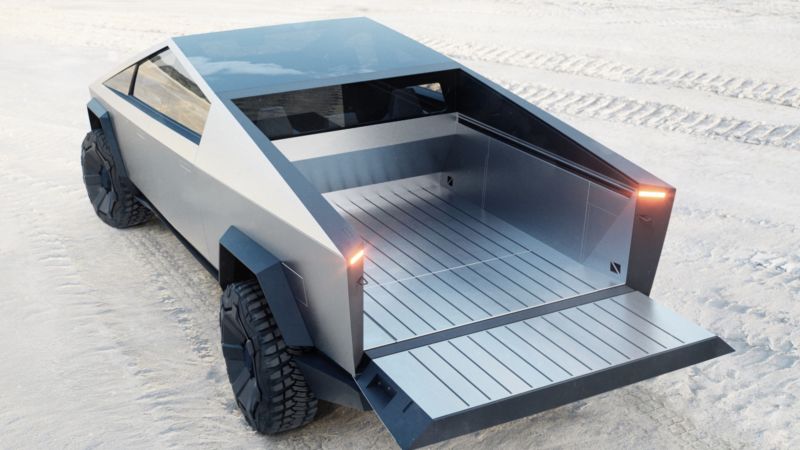The Tesla Cybertruck, at least in its first model year, will likely not be available in an inexpensive two-wheel-drive version, a document submitted to government regulators by the company said.
The document also reveals that the Cybertruck, like other electric trucks, will be heavy.
The document, posted online by the federal National Highway Traffic Safety Administration (NHTSA) was uncovered recently on a Cybertruck message board, and is a Vehicle Identification Number, or VIN, decoder. Every passenger vehicle sold in America is required to have a VIN, which is a string of 14 digits and letters, identifying the specific motor vehicle and certain details of its assembly. Unlike a license plate, it is permanently attached to the vehicle, but it’s hard to see without getting up close. It appears in several places on the vehicle, including on a stamped metal plaque visible through the lower portion of the windshield and on the inside of the driver’s side door frame.
The last part of a VIN is a string of random digits identifying that specific car, truck or SUV, distinguishing it from others that may look similar. But the first long portion provides information about the vehicle’s manufacturer, the model, where it was made and other information. By providing a VIN decoder, an automaker is telling regulators, and others, what all the digits and letters in roughly the first two-thirds of the VIN actually mean.
A VIN decorder can reveal a lot about an automaker’s plans for a given model through what is – and what is not – listed there. In the VIN decoder document for its 2024 model year vehicles, Tesla
(TSLA) reveals it may have no plan to offer a two-wheel-drive version of the Cybertruck, at least not in its first model year. A two-wheel-driver Cybertruck would, presumably, be less expensive than four-wheel-drive versions. Tesla
(TSLA) has said, in the past, that one would be offered as an entry-level model.
In the VIN decoder document, Tesla explains that the eighth figure in a Tesla’s truck VIN will be a letter indicating the type of drive system it has. There are letters designating two- and three-motor versions, which would be all-wheel-drive. In Tesla vehicles, as in most electric vehicles, all-wheel-drive is created by having one or two motors driving the front wheels and one or two driving the back wheels.
There is no letter listed as designating a single motor Cybertruck, indicating that won’t be an option for the 2024 model year. In another portion of the document, letters indicating single-motor versions of the Model 3 and Model Y are listed because that option has been offered and will, evidently, continue to be offered.
The sixth figure in the VIN indicates the vehicle’s Gross Vehicle Weight Rating, or GVWR. The GVWR indicates the maximum amount the fully loaded vehicle could weigh, including the vehicle itself, occupants and cargo. The lowest weight range listed is 8,001 to 9,000 pounds.
That’s about 2,000 pounds higher than the lowest GVWR for, by comparison, a Ford F-150. But it’s similar to the Gross Vehicle Weight Ratings for other electric pickups like the Ford F-150 Lightning and the Rivian R1T. Because of their heavy battery packs, electric trucks tend to weigh more than gas-powered trucks, adding as much as 2,000 pounds to their GVWR.
Tesla would not be unique in not offering a two-wheel-drive electric truck. Neither Ford or Rivian offers a two-wheel-drive version of their trucks. Tesla has not yet announced pricing for the Cybertruck but the company has said in the past the least expensive model would cost $40,000. If that turns out to be the case, that would be about $10,000 cheaper than the least expensive F-150 Lightning and much less than the Rivian R1T.
When Tesla first unveiled the Cybertruck in late 2019, no other automakers offered electric trucks on the market. Now, Ford, General Motors and the start-up automaker Rivian are already selling EV trucks. An electric Ram pickup is expected in about a year.
Tesla did not respond to emailed questions about its plans for the Cybertruck.
What’s more, GM recently postponed increasing production of its truck stating, in part, that it was doing so to adjust to consumer demand for the product. Various automakers have recently had to offered discounts on their electric vehicles to help clear backlogs of unsold EVs on dealer lots.
Tesla CEO Elon Musk recently admitted that the Cybertruck, with its body composed mostly of flat-sided bare metal, is very difficult to manufacture profitably, so it could make sense that the company won’t be offering the cheapest versions right way.
“I do want to emphasize that there will be enormous challenges in reaching volume production with the Cybertruck and then in making a Cybertruck cash flow positive,” Musk said on a recent earnings call.
Read the full article here













Leave a Reply